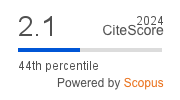Improving Student Grade Prediction Using Hybrid Stacking Machine Learning Model
DOI:
https://doi.org/10.4108/eetiot.5369Keywords:
Hybrid Model, Grade Prediction, Stack ModelAbstract
With increasing technical procedures, academic institutions are adapting to a data-driven decision-making approach of which grade prediction is an integral part. The purpose of this study is to propose a hybrid model based on a stacking approach and compare its accuracy with those of the individual base models. The model hybridizes K-nearest neighbours, Random forests, XGBoost and multi-layer perceptron networks to improve the accuracy of grade prediction by enabling a combination of strengths of different algorithms for the creation of a more robust and accurate model. The proposed model achieved an average overall accuracy of around 90.9% for 10 epochs, which is significantly higher than that achieved by any of the individual algorithms of the stack. The results demonstrate the improvement of prediction results but using a stacking approach. This study has significant implications for academic institutions which can help them make informed grade predictions for the improvement of student outcomes.
Downloads
References
Raja, R. & Nagasubramani, P.. (2018). Impact of modern technology in education. Journal of Applied and Advanced Research. 3. 33. 10.21839/jaar.2018.v3iS1.165.
Richiţeanu-Năstase, Elena-Ramona & Stăiculescu, Camelia. (2018). University dropout. Causes and solution. 1. 71-75.
Baradwaj, B.K.; Pal, S. Mining educational data to analyze students’ performance. Int. J. Adv. Comput. Sci. Appl. 2012, 2, 63–69
Bain, S.; Fedynich, L.; Knight, M. The successful graduate student: A review of the factors for success. J. Acad. Bus. Ethics 2011, 3, 1.
Guo, Gongde & Wang, Hui & Bell, David & Bi, Yaxin. (2004). KNN Model-Based Approach in Classification.
Cutler, Adele & Cutler, David & Stevens, John. (2011). Random Forests. 10.1007/978-1-4419-9326-7_5.
Chen, Tianqi and Carlos Guestrin. “XGBoost: A Scalable Tree Boosting System.” Proceedings of the 22nd ACM SIGKDD International Conference on Knowledge Discovery and Data Mining (2016): n. pag.
Popescu, Marius-Constantin & Balas, Valentina & Perescu-Popescu, Liliana & Mastorakis, Nikos. (2009). Multilayer perceptron and neural networks. WSEAS Transactions on Circuits and Systems. 8.
Kurz, S., De Gersem, H., Galetzka, A. et al. Hybrid modeling: towards the next level of scientific computing in engineering. J. Math.Industry 12, 8 (2022).
Daniel, B. Big data and analytics in higher education: Opportunities and challenges. Br. J. Educ. Technol. 2015, 46, 904–920.
Namoun, A.; Alshanqiti, A. Predicting Student Performance Using Data Mining and Learning Analytics Techniques: A Systematic Literature Review. Appl. Sci. 2021, 11, 237.
Jayaprakash, Sujith & Krishnan, Sangeetha & V, Jaiganesh. (2020). Predicting Students Academic Performance using an Improved Random Forest Classifier. 238-243. 10.1109/ESCI48226.2020.9167547.
Salal, Yass & Hussain, Mushtaq & Paraskevi, T.. (2021). Student Next Assignment Submission Prediction Using a Machine Learning Approach. 10.1007/978-3-030-71119-1_38.
Kanetaki, Zoe & Stergiou, Constantinos & Bekas, George & Troussas, Christos & Sgouropoulou, C.. (2022). A hybrid machine learning model for grade prediction in online engineering education.
Ghosh, H., Tusher, M.A., Rahat, I.S., Khasim, S., Mohanty, S.N. (2023). Water Quality Assessment Through Predictive Machine Learning. In: Intelligent Computing and Networking. IC-ICN 2023. Lecture Notes in Networks and Systems, vol 699. Springer, Singapore. https://doi.org/10.1007/978-981-99-3177-4_6
Rahat IS, Ghosh H, Shaik K, Khasim S, Rajaram G. Unraveling the Heterogeneity of Lower-Grade Gliomas: Deep Learning-Assisted Flair Segmentation and Genomic Analysis of Brain MR Images. EAI Endorsed Trans Perv Health Tech [Internet]. 2023 Sep. 29 [cited 2023 Oct. 2];9. https://doi.org/10.4108/eetpht.9.4016
Ghosh H, Rahat IS, Shaik K, Khasim S, Yesubabu M. Potato Leaf Disease Recognition and Prediction using Convolutional Neural Networks. EAI Endorsed Scal Inf Syst [Internet]. 2023 Sep. 21 https://doi.org/10.4108/eetsis.3937
Mandava, S. R. Vinta, H. Ghosh, and I. S. Rahat, “An All-Inclusive Machine Learning and Deep Learning Method for Forecasting Cardiovascular Disease in Bangladeshi Population”, EAI Endorsed Trans Perv Health Tech, vol. 9, Oct. 2023. https://doi.org/10.4108/eetpht.9.4052
Mandava, M.; Vinta, S. R.; Ghosh, H.; Rahat, I. S. Identification and Categorization of Yellow Rust Infection in Wheat through Deep Learning Techniques. EAI Endorsed Trans IoT 2023, 10. https://doi.org/10.4108/eetiot.4603
Khasim, I. S. Rahat, H. Ghosh, K. Shaik, and S. K. Panda, “Using Deep Learning and Machine Learning: Real-Time Discernment and Diagnostics of Rice-Leaf Diseases in Bangladesh”, EAI Endorsed Trans IoT, vol. 10, Dec. 2023 https://doi.org/10.4108/eetiot.4579
Khasim, H. Ghosh, I. S. Rahat, K. Shaik, and M. Yesubabu, “Deciphering Microorganisms through Intelligent Image Recognition: Machine Learning and Deep Learning Approaches, Challenges, and Advancements”, EAI Endorsed Trans IoT, vol. 10, Nov. 2023. https://doi.org/10.4108/eetiot.4484
Mohanty, S.N.; Ghosh, H.; Rahat, I.S.; Reddy, C.V.R. Advanced Deep Learning Models for Corn Leaf Disease Classification: A Field Study in Bangladesh. Eng. Proc. 2023, 59, 69. https://doi.org/10.3390/engproc2023059069
Alenezi, F.; Armghan, A.; Mohanty, S.N.; Jhaveri, R.H.; Tiwari, P. Block-Greedy and CNN Based Underwater Image Dehazing for Novel Depth Estimation and Optimal Ambient Light. Water 2021, 13, 3470. https://doi.org/10.3390/w13233470
Gong, Jing and Tao-An Chen. “Does Configuration Encoding Matter in Learning Software Performance? An Empirical Study on Encoding Schemes.” 2022 IEEE/ACM 19th International Conference on Mining Software Repositories (MSR) (2022): 482-494.
Samuels, Peter & Gilchrist, Mollie. (2014). Pearson Correlation.
Senthilnathan, Samithamby. (2019). Usefulness of Correlation Analysis. SSRN Electronic Journal. 10.2139/ssrn.3416918.
Muhammad Ali, Peshawa & Faraj, Rezhna. (2014). Data Normalization and Standardization: A Technical Report. 10.13140/RG.2.2.28948.04489.
Abdollahi, J., Nouri-Moghaddam, B. Hybrid stacked ensemble combined with genetic algorithms for diabetes prediction. Iran J Comput Sci 5, 205–220 (2022).
Zhu, Qiuming A.. “On the performance of Matthews correlation coefficient (MCC) for imbalanced dataset.” Pattern Recognit. Lett. 136 (2020): 71-80.
Grandini, Margherita et al. “Metrics for Multi-Class Classification: an Overview.” ArXiv abs/2008.05756 (2020): n. pag.
Downloads
Published
Issue
Section
License
Copyright (c) 2024 EAI Endorsed Transactions on Internet of Things

This work is licensed under a Creative Commons Attribution 3.0 Unported License.
This is an open-access article distributed under the terms of the Creative Commons Attribution CC BY 4.0 license, which permits unlimited use, distribution, and reproduction in any medium so long as the original work is properly cited.




